
By:
- Erika Johnson
Published Date
By:
- Erika Johnson
Share This:
Return to Learn By the Numbers
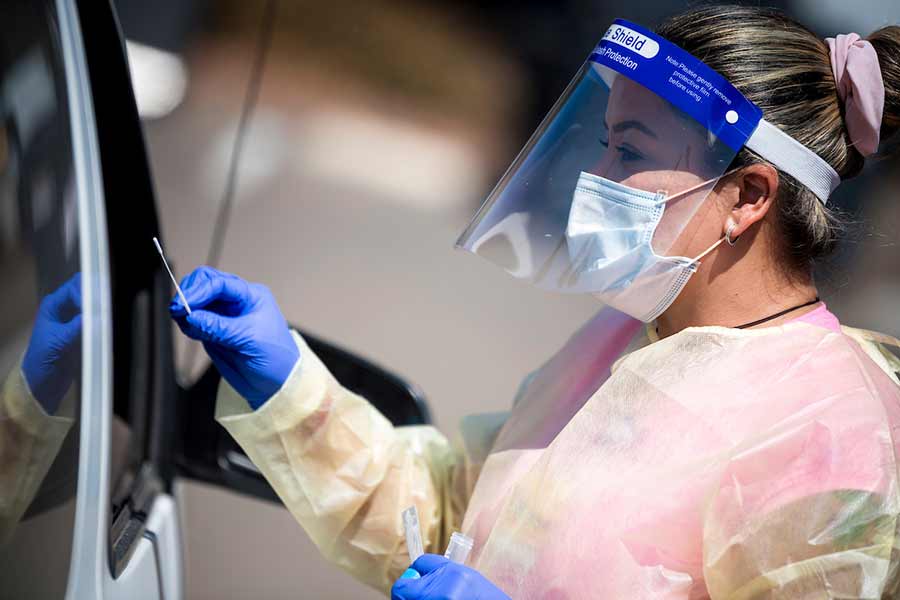
Photos by Erik Jepsen/UC San Diego Communications
Each day at UC San Diego, there is a finely tuned workflow of data modeling, nose swabbing, wastewater sampling, molecular sequencing and contact tracing. These and many other public health measures have been introduced and improved over the past year as part of the university’s Return to Learn program—an evidence-based formula to safely resume teaching, learning and research.
And the plan is working. UC San Diego’s positivity rates have remained far below average thanks to the dedicated teams that conduct thousands of COVID-19 tests each day, provide medical care for students, sanitize working and learning spaces, collect wastewater samples and more.
As we near the end of this tumultuous year, we review the scope of the continuously evolving Return to Learn program.
Risk Mitigation
Cleaning and Sanitation
UC San Diego’s Facilities Management team has been working diligently to provide daily disinfection services to keep campus community members safe. Their team of more than 200 staff members help sanitize light switches, door handles, elevator buttons, sinks, desktops and many other high touch surfaces each morning and evening. In addition, signage helps to remind students and employees to make use of sanitizing wipes and physically distance within each space.
1,500: Number of hand sanitizer stations that have been installed throughout the campus. Facilities Management has also added sanitizing wipe dispensers in all indoor and outdoor restrooms near classrooms.
200+: Number of staff involved in daily disinfection operations.
100%: All campus buildings ventilation filters have been replaced. Approximately 90% of all buildings have been retrofitted with hospital grade filters.
95: Number of electrostatic sprayers used to disinfect campus buildings and restrooms.
1-3 hours: Amount of time dedicated to disinfecting residential and workspaces after a campus individual tests positive.
Structural Reconfigurations
Fall quarter began with an incremental repopulation of the campus, maintaining a low density to provide plenty of space for effective physical distancing.
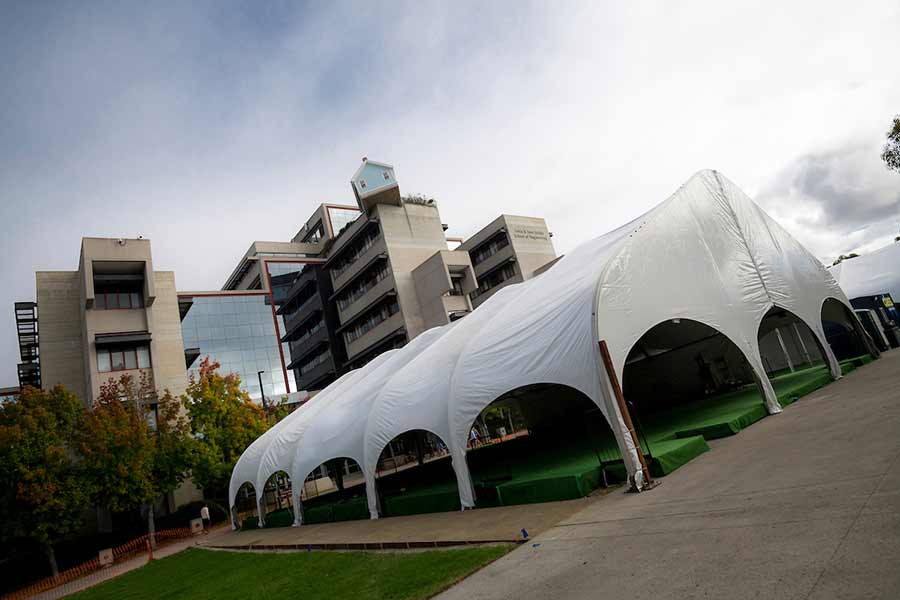
The flow of campus traffic has also been reconfigured; academic buildings, residence halls, and retail and dining facilities have been adjusted to provide one-way traffic into and out of spaces.
18,798: Number of employees working on campus during Fall quarter (20% of normal density).
9,129: Number of students who are living on campus during Fall quarter (50% of normal density). All students reside in single occupancy rooms.
50: Maximum number of students for in-person classes (or 25% of classroom capacity, whichever is smaller).
9: Number of outdoor tents erected to support outside lectures and study spaces for students, especially timely as all classes transitioned to remote or outdoor teaching in November in response to San Diego County’s purple tier designation.
Viral Detection
Testing
UC San Diego researchers have developed a rigorous viral testing program that is designed to detect potential outbreaks as early as possible. Testing is now being offered weekly at no cost to students and employees through UC San Diego Health. Tests are processed at the Expedited Covid IdenTification Environment (EXCITE) lab and the Center for Advanced Laboratory Medicine (CALM). Students also have the option to complete their testing requirements by picking up a self-administered testing kit. As a result of the multifaceted, proactive approaches, the campus’s positivity rates have remained low.
76,600+: Total number of student tests processed since March 1, 2020.
19,400+: Total number of employee tests processed since March 1, 2020.
1,000-1,500: Average number of tests processed on a daily basis.
16 hours: Average time for test results to be returned.
6: Number of drive-in and walk-up testing sites offered at no cost to campus community members through UC San Diego Health.
1.1%: Campus employee positivity rate (as of Dec. 6).
0.6%: Student positivity rate (as of Dec. 6).
Wastewater Monitoring
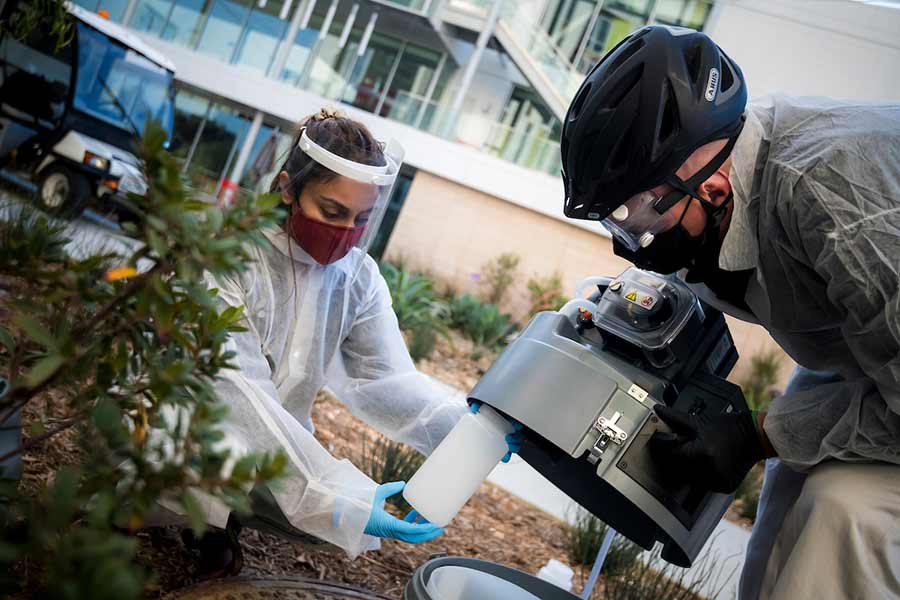
In the summer, UC San Diego launched a wastewater monitoring program, which enables researchers to detect the SARS-CoV-2 virus in wastewater three to five days ahead of an individual test. What began with six samplers has now grown to over 50, with the aim of quadrupling capacity in the near future. Samples are collected and processed daily at the Knight Lab in the UC San Diego School of Medicine.
52: Number of sampler machines distributed across campus. These are programmed to collect and store samples throughout the day to secure a 24-hour composite sample.
6: Number of research lab team members who collect samples each morning, a process that takes about two hours.
3: Number of steps involved in sample processing. These include concentration of viral RNA, extraction of nucleic acids and measuring the DNA through a quantitative polymerase chain reaction (qPCR) test.
2: Number of research lab team members who process samples each afternoon.
Intervention
The Return to Learn program strives to ensure that students living on campus with COVID-19 are provided support and a place to isolate, and that robust contact tracing is conducted to inform employees and students of potential exposures as quickly as possible.
Case Isolation
Contact tracing is conducted for students, employees and other individuals who test positive and are working or living at the university, led by UC San Diego’s School of Public Health.
Isolation and quarantine housing are available for undergraduate and graduate students who test positive for COVID-19 during the academic year.
300: Number of quarantine bedrooms available for asymptomatic campus residents.
300: Number of isolation bedrooms available for symptomatic campus residents.
Exposure Notification
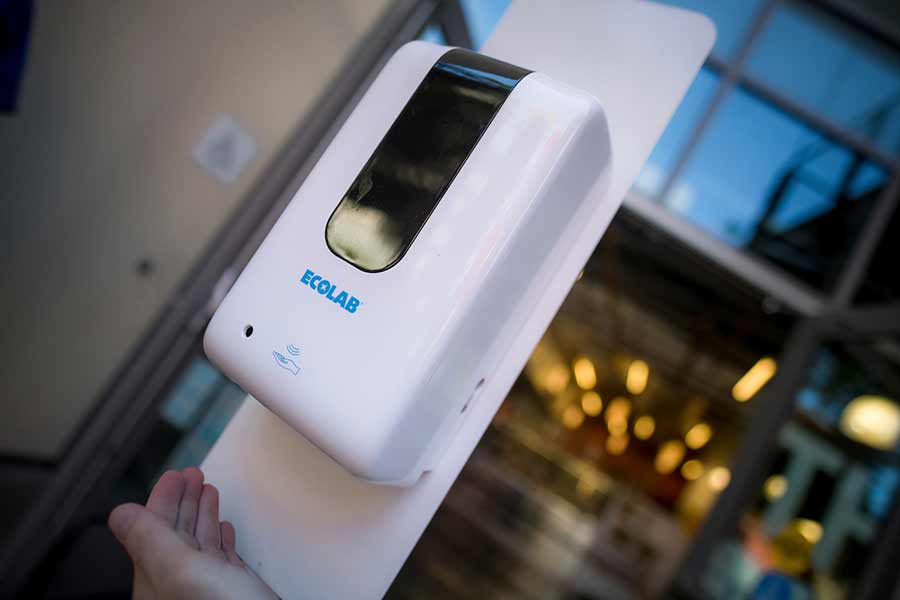
UC San Diego was a pilot site for the CA COVID Notify app throughout the summer and early fall. The program uses a smartphone’s Bluetooth capabilities to alert individuals if they have come in contact with someone who tested positive for the novel coronavirus in the last 14 days.
18,000+: Number of UC San Diego students and employees who have added the CA COVID Notify app—more than 50% of the on-campus population.
Treatment
UC San Diego Health treated the 13th and 14th documented cases of COVID-19 in the country and have successfully been doing so ever since.
743+: Number of patients hospitalized for COVID-19 at UC San Diego Health in 2020.
3: UC San Diego is a testing site for three of the largest COVID-19 Phase III vaccine clinical trials happening nationally, including Moderna AstraZeneca and Janssen/Johnson & Johnson.
Communication
New communication platforms have launched to amplify important messages, address concerns from the campus community and provide health and safety education. From newsletters to live town hall meetings and direct outreach, the communications team has been consistently conveying timely information.
676,000+: Number of unique visitors to the Return to Learn website since June 2020.
400+: Number of contact form submissions to the Return to Learn inbox, in addition to over one thousand additional emails sent directly.
400: Number of students serving as Triton Health Ambassadors to encourage a positive culture of health and provide peer-to-peer education and outreach.
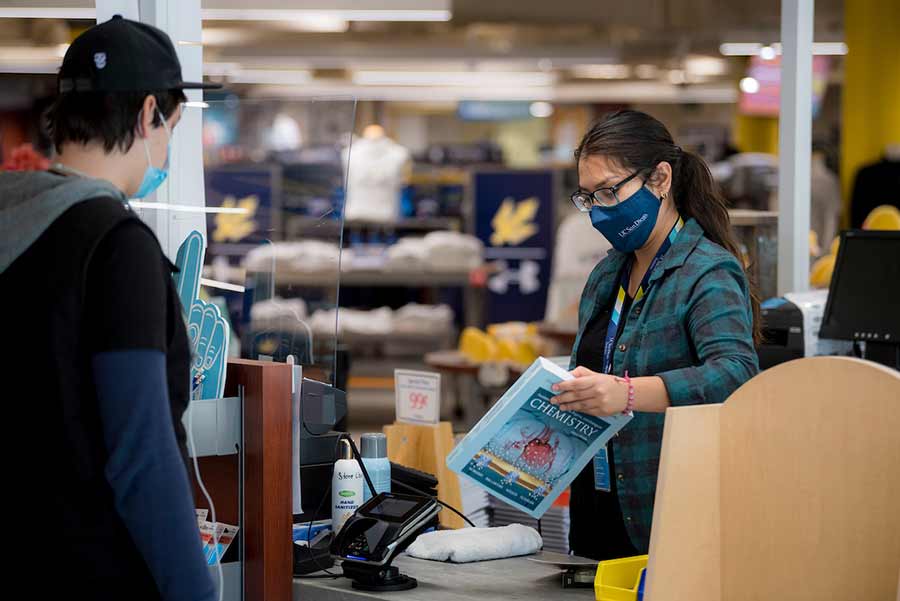
119: Number of campus notices that have been published—at times on a daily basis—regarding campus operations during the pandemic since January 2020.
19: Number of campus-wide town hall webinars hosted thus far, where campus leaders share updates and address questions related to campus operations during the pandemic.
18: Number of Q&A articles produced weekly to address the campus community’s most pressing questions about the rollout and implementation of the Return to Learn program.
14: Number of Return to Learn Weekly campus-wide newsletters distributed thus far to communicate important campus updates.
Share This:
You May Also Like
Stay in the Know
Keep up with all the latest from UC San Diego. Subscribe to the newsletter today.


